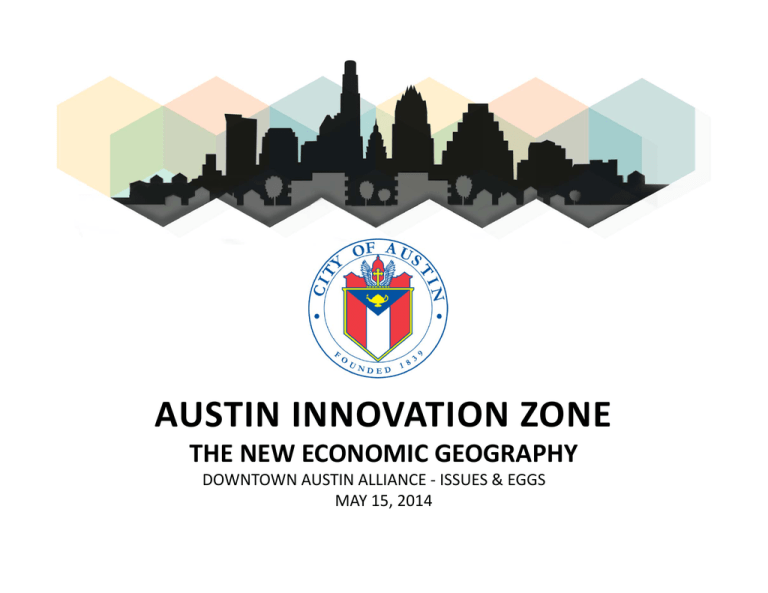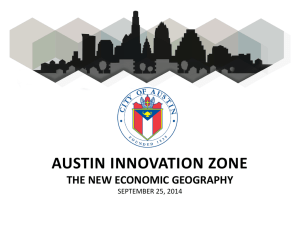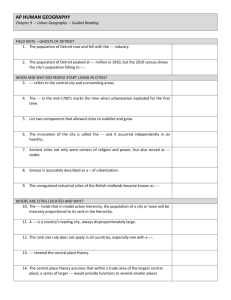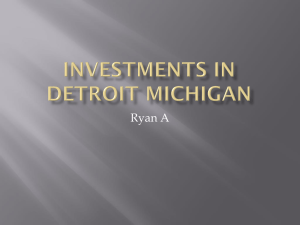AUSTIN INNOVATION ZONE - Downtown Austin
advertisement

AUSTIN INNOVATION ZONE THE NEW ECONOMIC GEOGRAPHY DOWNTOWN AUSTIN ALLIANCE ‐ ISSUES & EGGS MAY 15, 2014 VALUE OF AN INNOVATION DISTRICT • A hub of activity dedicated to collaboration, creativity and opportunity • A nexus for exchange of ideas and partnerships, among universities and businesses • A neighborhood to live, work, play and learn within walking distance to transportation – a sense of place. • A building providing views of academia and private industry interacting at work • A catalyst for job creation and economic development INNOVATION DISTRICTS– NATIONAL & INTERNATIONAL MODEL Existing or Developing Innovation Zones – – – – – – – – – Boston, MA Cambridge, MA San Francisco, CA Atlanta, GA Detroit, MI Philadelphia, PA St. Louis, MO Seattle, WA Raleigh-Durham, NC 22@BARCELONA GOVERNMENT TAKES THE LEAD Barcelona Activa, a local development agency wholly owned by the City of Barcelona, has spent over the last 20 years developing what appears to be the strongest entrepreneurial development program in Europe. The Barcelona Economic Triangle was designed to stitch together three separate economic cluster initiatives across the metropolitan area. Through the BET, the myriad of public and private actors jointly developed a common brand and strategy for attracting foreign investment. 22@Barcelona, one node of the Barcelona Economic Triangle. To remake an outmoded industrial area in the heart of the city into a hot‐bed of innovation‐driven sectors, the City of Barcelona designed a purpose‐driven urban renovation strategy. Changing area zoning from industrial to services and increasing allowable density essentially rewired the area. Parc de l’Alba, another node of the Barcelona Economic Triangle. Located seven miles north of Barcelona, 840 acres of predominantly public‐owned land, the Parc de l’Alba was designed to address three perplexing challenges: sprawling land use, specialization , and social segregation. CORTEX INNOVATION COMMUNITY UNIVERSITY TAKES THE LEAD Cortex, a consortium of Washington University in St. Louis, the University of St. Louis, the University of Missouri, St. Louis, and the Missouri Botanical Garden acquires over 200 acres and becomes a Chapter 535 – with zoning, taxing, and eminent domain powers. Washington University in St. Louis has moved their Innovation and Tech Transfer offices into @4240, moved magnetic research to the community, and created linkages across the institution. Concentration of Innovation Centers – CIC has moved its first location outside of Cambridge/Boston into @4240. Has become a magnetic for companies large and small. Also coming to @4240 is Tech Shop, Impact HUB, Venture Café Foundation Boeing Ventures, the aerospace giant is locating its venture and innovation efforts at @4240 to take advantage of recruiting, M&A, and talent acquisition opportunities. DOWNTOWN DETROIT BUSINESS TAKES THE LEAD Quicken Loans/Rock Ventures, Dan Gilbert invests over $1 billion in 2.6 million SF in downtown. Gilbert’s confidence has sparked decisions by other firms and entrepreneurial tech‐oriented start‐ ups, such as Digerati, Detroit Labs, and Stik. Kresge Foundation contributed $50 million toward a major public‐ private reclamation and redevelopment project along the city’s riverfront. Invest Detroit, the Detroit Downtown Partnership, and the Detroit Economic Growth Corporation have nurtured these deals and the broader revival for years. Midtown Detroit Inc. is leading a revival of that neighborhood driven by four major anchor institutions—Henry Ford Hospital, the Detroit Medical Center, Wayne State University, and the College for Creative Studies. Wayne State University, the largest public research university in the city of Detroit, is building a $90 million biomedical research facility to link up with researchers at the Henry Ford Health System and is home to TechTown, a technology research center and business incubator. The College for Creative Studies, one of the top design colleges in the world, expanded in 2008 with a $145 million redevelopment of the historic Argonaut Building (formerly General Motors’ first research and design studio). The building of M1 Rail, a 3.3 mile light‐rail line from downtown to Grand Boulevard at the upper edge of Midtown Detroit. A consortium of public, private, and philanthropic institutions— including General Motors and Chrysler, the Kresge Foundation, Dan Gilbert, Roger Penske, and Peter Karmanos (the CEO of have committed more than $100 million to construction of the project. CHANGE IS IN THE AIR • A shift in many state and municipal economic development efforts in favor of business expansion and creation over pure incentive- laden attraction. • Focus on corporate profits keeping in-house R&D to a minimum and encouraging partnerships with Universities. • Movement of Universities (esp. metropolitan, from passive participants to active leaders in regional economic development. • Evolution from lone wolf to wolf pack invention. • Universities viewed as valued sources of know-how in addition to technology. A NEW MODEL Suburban URBAN Automotive PEDESTRIAN Disintegrated INTEGRATED Homogeneous DIVERSE Inflexible ADAPTABLE Dull INSPIRING ELEMENTS OF THE NEW MODEL Research Institutions Academic Institutions Government Private Sector Land Developers Venture Capital Entrepreneurs Non Profits Quasi-Governmental Entities PRODUCTIVE GEOGRAPHY 2.0 RESEARCH TRIANGLE PARK RALEIGH-DURHAM, NC KENDALL SQUARE Cambridge Innovation Center More startups than anywhere else in the world. • Founded in 1999 • Enterprises Created: Over 1,500 • Jobs Created: 40,000 • Investment Dollars: $2 Billion • Tenant Companies: 600 SOUTH BOSTON WATERFRONT Mass Challenge Catalyze a startup renaissance. • Founded in 2010 • Startups Accelerated: 361 • Jobs Created: 2,912 • Funding Dollars Raised: $362 Mil THE SCIENCE OF OPPORTUNITY TEXAPHYRIN US Patent No. US6375930 Priority Date: June 4, 1996 Adams, A. (1998). "AAAS MEETING: 10‐Gallon Molecule Stomps Tumors". Science 279 (5355): 1307b. Created by: Jonathan L. Sessler, Ph.D. Professor and Rowland Pettit Centennial Chair in Chemistry The University of Texas at Austin • • • • • • • • CEO: Robert W. Duggan Focus: Cancer and immune mediated diseases Location: Sunnyvale, CA Employees: 484 Stock Price (PCYC): $90.04 (3/31/2014) Market cap: $6.73 billion Revenue: $260.17 million Earnings: $67.01 million WHY AUSTIN? Austin is at the intersection of success and opportunity – – – – – – Development of new medical school/teaching hospital High level development in Northeast Downtown Corridor High concentration of local talent Culture that attracts more talent Strong Economy Dynamic start‐up/entrepreneurial community THE ZONE HOW TO MAKE IT WORK 1 2 3 ELEMENTS OF A PHYSICAL ENVIRONMENT VIBRANT MIXED‐USE COMMUNITY ELEMENTS OF THE INNOVATION ECOSYSTEM TALENT ATTRACTION AND SUPPORT ELEMENTS OF COMMUNITY ENGAGEMENT EXPAND SOCIAL AND ECONOMIC FABRIC 1 THE POWER OF PROXIMITY VIBRANT MIXED‐USE COMMUNITY LAB OFFICE + RESEARCH BUILDINGS Create Spaces Suited to Emerging Innovation Clusters Clinical and Academic Space Flex / Cool Space Lobbies and Spaces that Promote Collaboration • • • • • • • A Spiritual Icon to Define the Community Lobbies and Street Science Express the Knowledge Community in a Compelling Way • Transform While Preserving Future Opportunities Open Spaces Activating Public Spaces Live, Work, and Play Multi‐Modal and Transit‐Oriented THE INNOVATION ECOSYSTEM DRIVES MULTI‐DIMENSIONAL UNIVERSITY ENGAGEMENT LEVERAGE UNIVERSITY INTELLECTUAL CAPITAL, INNOVATION, INFRASTRUCTURE • • • • • • • 3 • HOUSING AND HOTEL • • 2 MAJOR RETAIL AND TEMPORARY USES ICONIC SPIRITUAL CENTER Access to Talent (faculty & student) Technology Transfer Application to Know‐How CORE Facilities and Labs Student Entrepreneurism Corporate Attraction Programming and Events CONCENTRATE ELEMENTS FOR REGIONAL INNOVATION HUB • • • • • • • • Innovation Centers – Cambridge Innovation Center Fab Labs and Maker Spaces Incubation and Acceleration Mentorship and Support Corporate Innovation Spaces Regional Economic Development Community College and Work Force Development Programming and Events PROSPERITY FOR THE COMMUNITY AND BEYOND EXPAND SOCIAL AND ECONOMIC FABRIC PHYSICAL REVITALIZATION • • • • • • Mixed‐use redevelopment, retail Public safety Sustainable & Green elements Bike paths, parks, greening, walkability, transits Neighborhood marketing Employer‐assisted housing HUMAN CAPITAL • • • Workforce Development Education Economic opportunity WHAT’S MISSING? WHAT’S MISSING? • Wet lab space • 60,000 sq ft of wet lab space • 150,000 sq ft facility WHAT’S MISSING? $ 1.8 B WHAT DO WE HAVE? ***TALENT TRUMPS ALL*** PATH FORWARD • Engage Stakeholders • Mayor’s Innovation Zone Advisory Group • Community Outreach • Align Plans • Multiple master plans influencing the innovation zone • Develop Vision • Create a vision and values specific to Austin Innovation Zone • Create a platform for execution • Develop mechanism to continue to engage dialogue and initiate action among stakeholders BIG QUESTIONS • How do you support and catalyze “innovation”? • Is it organic? Can it be done by design? • Can we create and sustain a culture for “innovation”? • What do we hope to gain from an Innovation Zone? • What is success? How do we know if we’ve achieved it? SLY MAJID Chief Service Office – Office of Mayor Lee Leffingwell sly.majid@austintexas.gov SPECIAL THANKS TOM OSHA Managing Director of Innovation & Economic Development



